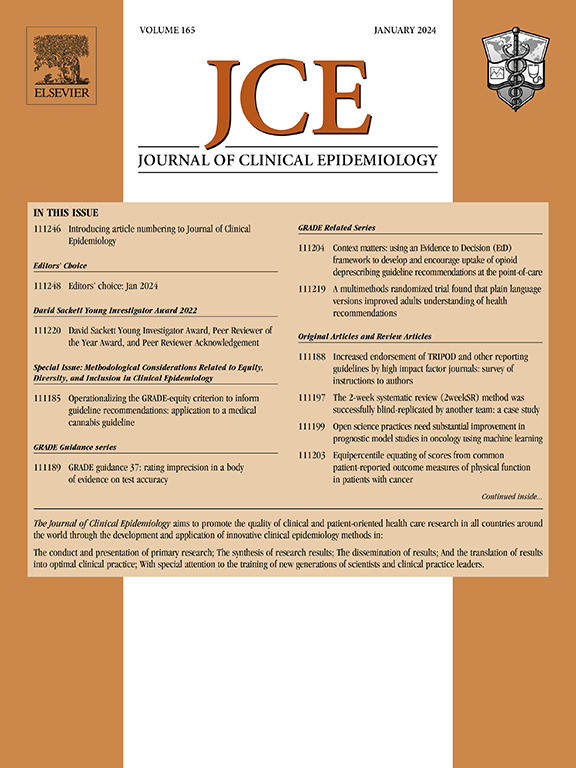在瑞士HIV队列研究中实施随机化同意,使队列试验(TwiCs)成为可能——一项混合方法研究。
IF 5.2
2区 医学
Q1 HEALTH CARE SCIENCES & SERVICES
引用次数: 0
摘要
目的:群内试验(TwiCs)是一种有前途的设计,使随机试验更有效。要求队列参与者同意在队列中随机选择未来的低风险干预措施。为了在瑞士HIV队列研究中启用TwiCs,我们将这种“随机同意”添加到方案中,并随后接触队列参与者以获得书面同意。本研究描述TwiCs的实施过程。研究设计和设置:我们采用混合方法设计来评估实施过程。我们使用队列数据来描述接受和拒绝随机化同意的参与者。我们对队列医生进行了横断面调查,以收集有关TwiCs设计的意见和经验。我们与相关利益相关者(医生、研究人员、参与者和伦理委员会成员)进行了半结构化访谈,以深入了解实施随机化同意的态度、障碍和促进者。此外,我们在提供随机化同意的队列访问中进行了观察。结果:在2024年7月至2025年7月期间,5297名队列参与者中,3067名(57.9%)接受随机化,734名(13.8%)拒绝随机化同意。在1496例(28.2%)病例中,决定推迟到下一次访问。男性、年龄较小、受教育程度较高、接受过至少三次固定医生咨询以及较短的队列参与时间显示出较高的接受度。接受采访的参与者表示,他们拒绝同意的原因是害怕额外的努力和对研究缺乏兴趣。队列医生和研究人员对TwiCs的总体看法是积极的。他们认识到有可能简化试验的进行,特别是在测试低风险干预措施方面。对TwiCs同意程序的伦理担忧很少见。然而,伦理委员会成员认为明确的随机化同意是必要的,而一些医生和参与者对没有明确同意的随机化持积极态度。随机化同意书的推出由训练有素、积极主动的人员推动,并无缝整合到临床常规中。医生在同意过程中的主要障碍是语言障碍,参与者难以理解概念,以及由于紧张的会诊时间表而造成的时间限制。结论:TwiCs设计的实施,包括在现有的大规模队列中推出随机化同意是可行的。参与者的接受率很高。本文章由计算机程序翻译,如有差异,请以英文原文为准。
Implementing a randomization consent to enable Trials within Cohorts in the Swiss HIV Cohort Study – A mixed-methods study
Objectives
Trials within Cohorts (TwiCs) is a promising design to make randomized trials more efficient. Cohort participants are asked for consent to be randomized into future low-risk interventions tested within the cohort. To enable TwiCs in the Swiss HIV Cohort Study, we added this “randomization consent” to the protocol and approached cohort participants subsequently for written consent. This study describes the TwiCs implementation process.
Study Design and Setting
We used a mixed methods design to evaluate the implementation process. We used cohort data to characterize participants accepting and declining randomization consent. We conducted a cross-sectional survey with cohort physicians to gather opinions and experiences regarding the TwiCs design. We did semistructured interviews with involved stakeholders (physicians, research personnel, participants, and ethics committee members) to get insights about attitudes, barriers, and facilitators implementing the randomization consent. In addition, we performed observations in cohort visits where the randomization consent was offered.
Results
Between July 2024 and July 2025, among 5297 cohort participants approached, 3067 (57.9%) accepted and 734 (13.8%) declined the randomization consent. In 1496 (28.2%) cases the decision was postponed to the next visit. Male sex, younger age, higher education, being consulted by a steady physician for at least three visits, and shorter cohort participation time showed higher acceptance rates. Interviewed participants cited fear of additional effort and a lack of interest in research as reasons for declining consent. The overall perception of TwiCs among cohort physicians and research personnel was positive. They recognized the potential to simplify the conduct of trials, especially to test low-risk interventions. Ethical concerns on the TwiCs consent procedure were rare. However, an explicit randomization consent was considered necessary by members of ethical committees while several physicians and participants felt positive about randomizing without explicit consent. The roll-out of the randomization consent was facilitated by well-trained, motivated personnel, and seamless integration into clinical routine. Main barriers for physicians in the consenting process were language barriers, participant difficulty understanding the concept, and time constraints due to tight consultation schedules.
Conclusion
The implementation of the TwiCs design, including the roll-out of a randomization consent in an existing, large-scale cohort, is feasible. The acceptance rate among participants was high.
求助全文
通过发布文献求助,成功后即可免费获取论文全文。
去求助
来源期刊

Journal of Clinical Epidemiology
医学-公共卫生、环境卫生与职业卫生
CiteScore
12.00
自引率
6.90%
发文量
320
审稿时长
44 days
期刊介绍:
The Journal of Clinical Epidemiology strives to enhance the quality of clinical and patient-oriented healthcare research by advancing and applying innovative methods in conducting, presenting, synthesizing, disseminating, and translating research results into optimal clinical practice. Special emphasis is placed on training new generations of scientists and clinical practice leaders.
 求助内容:
求助内容: 应助结果提醒方式:
应助结果提醒方式:


